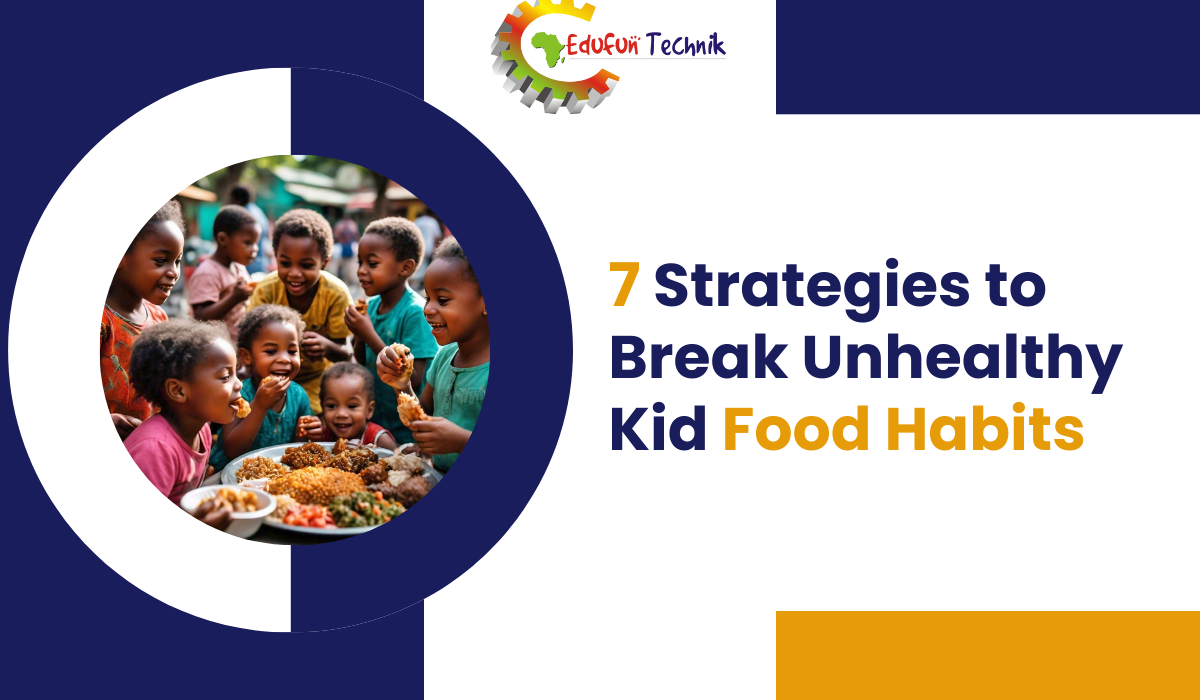Getting kids to eat nutritious foods can sometimes feel like an uphill battle. Unhealthy snacks and sugary drinks are everywhere these days, making it all too easy for our little ones to develop some not-so-great eating habits.
Don’t worry, it’s never too late to make a change. With a little patience and the right strategies, we can help our children develop a love for wholesome, nourishing foods that will set them up for a lifetime of health and wellness.
That’s why today, we’re going to share 8 powerful strategies to break those unhealthy kid food habits and get them excited about nutritious choices.
Lead by Example
You know what they say, kids learn best by watching the adults in their lives. That’s why one of the most powerful strategies for breaking unhealthy food habits is to lead by example. When our children see us making nutritious choices and enjoying wholesome foods, they’re much more likely to follow suit.
So, let’s start by taking a good look at our own eating habits. Are we reaching for those sugary snacks or processed treats when we’re feeling peckish? Or are we fueling our bodies with fresh fruits, veggies, and other nourishing options?
But leading by example isn’t just about what we eat; it’s also about how we talk about food. Avoid labeling foods as “good” or “bad,” and instead focus on the idea of balance and moderation. After all, we want our children to develop a healthy relationship with food, not an unhealthy obsession.
Another great way to model healthy habits is to involve your children in the meal planning and preparation process. Let them help you pick out fresh produce at the market, and teach them simple cooking skills. When kids feel like they’ve played a role in creating their meals, they’re much more likely to be excited about eating them.
So, let’s commit to being the positive role models our children need. By making nutritious choices and involving our little ones in the process, we can pave the way for a lifetime of healthy eating habits.
Make Healthy Foods Appealing
Kids are often drawn to unhealthy snacks because of how they look and taste. Those bright colors, fun shapes, and sugary flavors can be hard to resist for little ones. But guess what? With a little creativity, we can make healthy foods just as appealing.
The first step is to get your kids involved in the process. Let them help you pick out fresh, colorful fruits and veggies at the market or grocery store. Children are much more likely to get excited about foods they’ve had a hand in selecting.
Next, get creative with the presentation. Use cookie cutters to turn ordinary sandwiches into fun shapes, or arrange fruits and veggies into smiley faces or other designs on their plates. You can even give healthy snacks fun, kid-friendly names.
Another tip? Don’t be afraid to get a little messy. Let your kids dip their fruits and veggies into yogurt or nut butter dips, or create their own trail mixes by mixing their favorite nuts, seeds, and dried fruits. The more senses you engage, the more appealing the healthy snacks will seem.
And remember, it’s all about balance. While we want to make nutritious foods as appealing as possible, it’s okay to indulge in a treat now and then. The key is to make sure those unhealthy options aren’t the norm.
Limit Unhealthy Food Options
It’s usually a struggle trying to encourage your child to make healthy choices, but those tempting unhealthy snacks are just staring them in the face every time they open the pantry or fridge.
That’s why limiting the availability of unhealthy options at home and at school is such an important strategy. Now, we’re not saying you have to go full-on drill sergeant and ban all treats forever. That’s just setting everyone up for failure. But by making unhealthy snacks the exception rather than the norm, you’re removing a huge source of temptation.
Start by taking a good, hard look at what’s in your kitchen cupboards and fridge. Toss out anything that’s loaded with empty calories, excess sugar, and other not-so-great ingredients. Then, replace those items with plenty of healthy, nutrient-dense alternatives like fresh fruits, veggies, whole grains, proteins, and healthy fats.
When it comes to snack time, make sure those better-for-you options are front and center. Keep a bowl of fresh fruit on the counter, and stock the fridge with pre-portioned veggie packs or yogurt cups. That way, the healthy choice is the easy choice.
And if you’re really struggling to keep those unhealthy temptations at bay, enlist some help. Get the whole family on board, or even ask your child’s teacher to limit sugary, processed snacks in the classroom. Remember, it takes a village to raise healthy eaters.
Offer Rewards and Incentives
Kids love rewards but instead of using food as a reward, try mixing it up with non-food options. Stickers, praise, or a special activity can be powerful motivators for trying new healthy foods. Kids beam with pride when they get that stamp of approval or fun reward for making a nutritious choice.
I know it’s tempting to use their favorite treats as incentives, but try to avoid that trap. Using unhealthy foods as rewards can inadvertently teach kids that those items are more valuable. It reinforces using food as an emotional tool instead of nourishment.
The goal is creating positive associations around healthy eating without making junk food the prize. Get creative with rewards that don’t involve food – an extra bedtime story, a fun craft, or picking the next family movie night. These types of incentives emphasize healthy habits without using food as a bargaining chip. Your kids will start to see nutritious choices as something to be celebrated.
Get Active Together
You know what goes hand-in-hand with healthy eating? Getting your bodies moving. Physical activity and good nutrition are a powerful duo for kids’ overall wellness.
Think about it – when you’re active and working those muscles, you’re using up energy. And guess what helps re-energize your body afterward? Nutritious foods! The two just make sense together.
That’s why making fitness a family affair can reinforce those healthy habits. Getting active together shows kids that energy from wholesome meals can fuel fun activities you all enjoy. Bike rides, hikes, dancing parties in the living room – the options are endless!
The great thing about family fitness is that it doesn’t have to feel like a chore. Games like tag or soccer in the backyard get everyone’s hearts pumping while creating laughter and bonding moments. You’d be surprised how quickly a walk around the neighborhood becomes a quest to find the most interesting leaf or rock.
Involve Children in the Process
You know what kids love? Having a sense of ownership and responsibility. Getting them involved in the healthy eating process from start to finish can work wonders for generating excitement around nutritious foods.
Start at the grocery store. Even little ones can help out here. Younger kids can practice identifying fruits and veggies. Older children can read nutrition labels or make suggestions of healthy items to try that week. Let them feel invested by weighing in on what goes in the cart.
Once you’re home, keep them engaged by assigning age-appropriate tasks during meal prep. Preschoolers can rinse produce or tear lettuce for salads. Elementary kids might measure ingredients, mix batter, or set the table. Teenagers can take the lead chopping veggies or plating portions. Cooking together is quality time.
The key is giving children an active role based on their skills and interest level. They’ll feel so proud knowing a part of the healthy meal was all their hard work. You’re creating positive associations with fresh, whole ingredients.
Involving kids in the process makes it an engaging learning experience rather than a chore. Planning, shopping, prepping – they’ll soak up so much about balanced nutrition naturally. And you’ll raise their curiosity to try new healthy recipes or globally-inspired dishes.
Be Patient and Persistent
Changing habits is no easy feat, especially when it comes to kids and eating. As parents, we know firsthand how challenging it can be to get little ones excited about trying new foods, let alone establishing consistent healthy eating habits.
But here’s the thing – it’s a process that requires time, effort and most importantly, patience. The key is staying consistent and not giving up, even when the veggies get thrown on the floor for the millionth time. Kids pick up on our attitudes, so if we stay positive and keep offering a variety of healthy options, eventually it will click for them. It may take 10 tries or 20 tries before they’ll even lick a Brussels sprout, but that small win is still a win!
So hang in there, stay strong, and keep those healthy foods coming. Your perseverance is teaching them incredible lifelong lessons about nourishing their bodies. One bite at a time, one day at a time. Just don’t lose that patience, it’s worth its weight in gold.
Instilling healthy eating habits in kids is one of the greatest gifts we can give them. It’s an investment in their long-term wellbeing that will pay dividends for years to come.
From making mealtimes fun and involving kids in meal planning/prep, to leading by example and being patient through the process, each of these strategies plays a crucial role. They nurture children’s curiosity about food, build positive associations, and lay the foundation for a lifetime of healthy choices.
It’s not always easy. If you ever feel stuck or overwhelmed, remember you don’t have to go it alone. Lean on other parents, teachers, pediatricians, or community resources for fresh ideas and support.







